
You are in :
Shallow Water

Seagrass and Corals
Seagrass are submerged vascular plants that play an essential role in the marine ecosystem of Abu Dhabi. They are the primary food source for Dugongs and provide habitat for many fish species. In contrast to other submerged marine plants such as seaweeds, seagrass flower, bear fruit and produce seeds. The extensive shallow coastal waters of Abu Dhabi Emirate also provide suitable conditions for several species of reef-building corals. Coral diversity in the Gulf is relatively low with fifty-five to sixty recorded species (compared to ~400 on Australia's Great Barrier Reef). The branching coral known as Acropora and Boulder Coral Porites are the main builders of the Emirate's limited and threatened reefs. With seawater temperatures and salinity levels close to or exceeding tolerance limits, corals are seriously constrained. Furthermore, temperature increases due to climatic changes appear to be occurring with greater frequency, causing mass mortality of corals with losses of up to ninety-eight per cent.
Indo-Pacific Humpback Dolphin
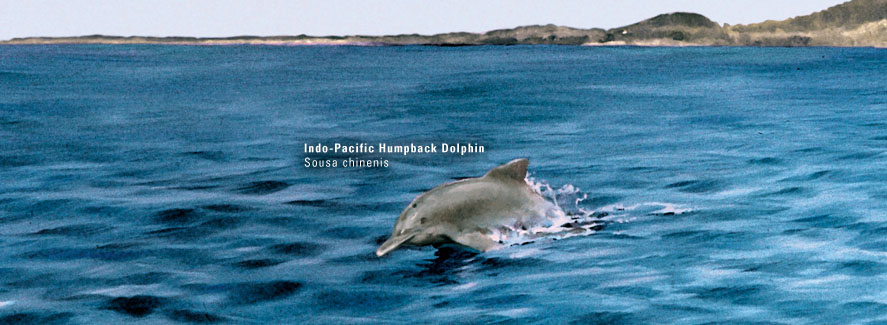
Shy, sedate and far less common than the Bottle-nosed Dolphin are Humpback Dolphins and Finless Porpoises. Although the Finless Porpoise is extremely rare, it is not uncommon to see humpback dolphins in the natural and man-made channels off Abu Dhabi Island. Alarmingly, estimates of Cetacean abundance in the UAE dropped by as much as 70% between 1986 and 1999 as a result of at least two die-off events. The cause of the die-off remains unknown although a ‘red tide' was suggested as a possible explanation.
Marine Turtles – Migration
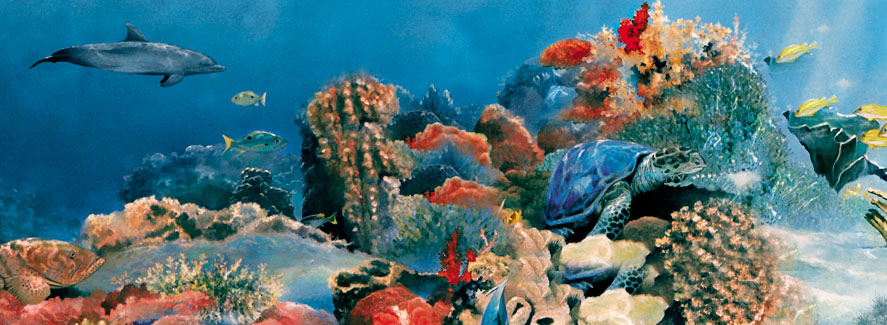
Marine turtles have migrated through the oceans for over 100 million years, their grazing habits helping to maintain the balance between habitats such as coral reefs and seagrass beds. After leaving the beach where they hatch from eggs, they travel to sometimes distant feeding grounds and spend their lives searching for places to feed. No matter how far they travel, though, females return to the same nesting site, year after year. Green Turtle populations migrate along the coast from nesting to feeding grounds. Tag returns from Green Turtles in Abu Dhabi waters show they nest along the Omani coast. Although Hawksbill Turtle migration is still being studied, data shows that they do not leave the Gulf, moving between foraging sites from Iranian to Qatari, Bahraini and UAE waters, often in a cyclical pattern.
Pearls-Treasures of the Gulf

Pearling in the UAE dates back over 7,000 years. At the beginning of the twentieth century, there were over 1,200 pearling boats operating in the region. In the Gulf, two oyster species (Pinctada radiata and Pteria penguin) were harvested, of which Pteria penguin was the most common source of pearls. Pearls are formed when an irritant, such as a grain of sand, enters the oyster's shell. To reduce the irritation, oysters secrete nacre from their mantle tissue. Overlapping layers of nacre interact with light to give pearls their lustrous appearance and prized value.
Seagrass in Abu Dhabi
Three species (Halodule uninervis, Halophila ovalis and Halophila stipulacea) grow in the coastal waters of Abu Dhabi Emirate. Diverse habitats such as shallow sandy bays, mangrove flats and shallow, open coasts all support seagrass. Halodule uninervis occurs in all habitats and sediment types. However, Halophila ovalis and Halophila stipulacea are more selective and prefer sand-coral and mud-sand conditions.
Importance of Fisheries
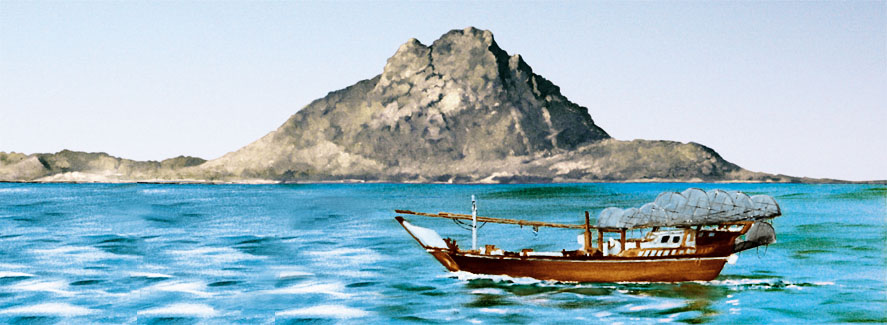
Evidence from archaeological sites on the coast and islands of Abu Dhabi suggests that people in the region have depended upon marine resources such as fish and pearls for over 7,000 years. As tools and fishing methods improved over time, a simple subsistence lifestyle gradually grew and flourished as fisheries became the mainstay economic activity of communities along the coast. Today, the economic importance of fisheries is far less than it was before the Great Depression of the 1930s. This global economic downturn, further exacerbated by the advent of cultured pearls from Japan during this same period, sent the pearling industry in Abu Dhabi into sharp decline. Nevertheless, fisheries still maintain a significant cultural and socio-economic role in the more isolated coastal and island communities of the Emirate.
Managing Gargoor Fishing
Gargoors are fish traps that have been used across the region for thousands of years. Previously constructed from date palm fronds, they are now made from galvanised wire. The Gargoor fishery poses significant risks in relation to achieving sustainable fisheries. Ghost fishing occurs when lost traps inadvertently continue to catch fish. Furthermore, growth and recruitment in the industry has been attributed to the intensity of fishing and the small size at which fish become vulnerable to capture. Consequently, EAD has introduced a number of management measures to regulate gargoor fishing operations including the compulsory use of juvenile escape panels which are intended to reduce the catch of immature fish.
Dugongs
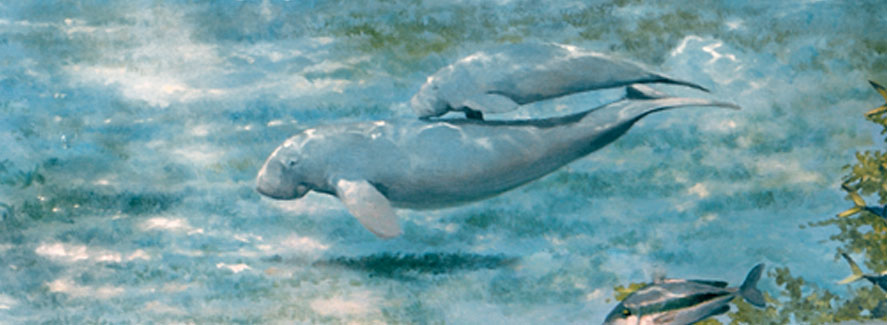
The Dugong (Dugong dugon) is the only true marine herbivore, resembling a cross between a seal and a whale. Grey–brown in colour, it has a powerful fluked tail and small front flippers, which act like paddles and stabilisers during swimming. The forelimbs are used for scratching, mouth-cleaning and supporting the body while resting on the sea-bottom. They measure about 2–4 metres in length and weigh up to 400 kg. An air breathing mammal, sometimes called a ”sea cow”, they are specially adapted to life in the sea, spending much of the time grazing on seagrass. Although the International Union for Conservation of Nature (IUCN) considers Dugongs to be vulnerable to extinction globally, Abu Dhabi hosts a large and growing population – a strong indication of the global significance of Dugong protection in the Emirate.
Mermaids of the Sea'
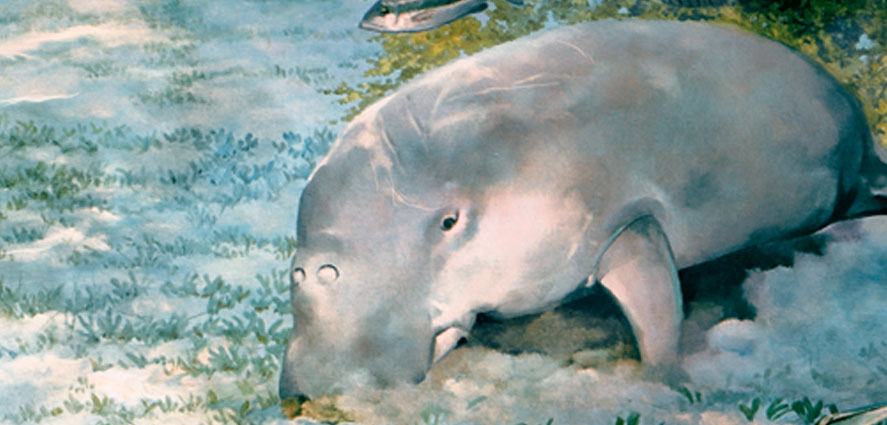
It is not surprising, that the legend of the mermaid may have originated from the Dugong, given their shape and movement in the water. Archaeologists have found Dugong bones at sites on Dalma and Marawah that are over 7,000 years old. Dugong were still hunted locally as late as the 1970s, the meat being sold in the Abu Dhabi fish market. Today, Dugong are strictly protected and recognised as one of the most unique and globally endangered sea mammals in the world.

















